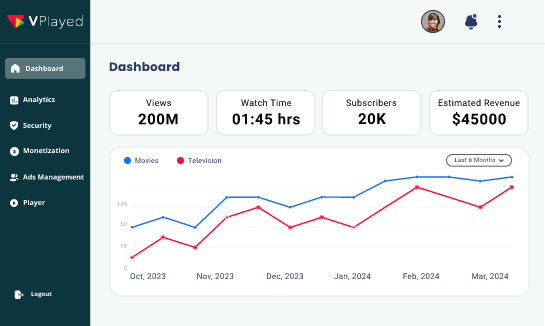Start and Grow Your OTT Streaming Application With 1000+ Features & 10+ Revenue Models.
Book a Free DemoWebOS Vs Android TV: What Are They & How They Differ?
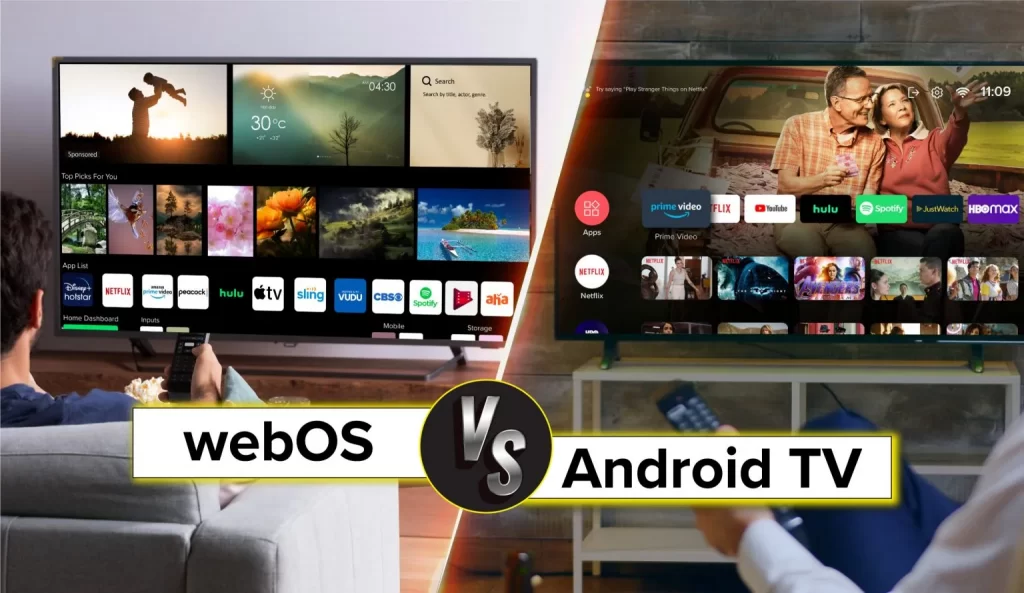
In this current age of smart TVs, the names WebOS and Android TV resonate as the most frequently encountered players in the field of integrated operating systems.
The landscape of smart TV brands is marked by their adoption of these systems, each showcasing a visually appealing interface characterized by a minimalist and professional design.
A mere push of a button on your remote control opens a bar housing an array of popular apps and TV features.
Despite the shared features between these operating systems, WebOS and Android TV are distinct in their own right.
Regardless of your field—whether you are immersed in the online video streaming industry or simply enjoy streaming shows on a smart TV—grasping.
The distinctions between WebOS and Android TV is pretty much important for making well-informed decisions.
This blog seeks to delve into these two prominent operating systems, offering an in-depth understanding of their unique features and functionalities.
With this in mind, let’s know more about developing LG WebOS TV app in the immediate next section.
- Fully Customizable
- Lifetime Ownership
- On-Premise/On-Cloud
- 100% White-label
- Zero Revenue Share
- Hire Developers
Table of Contents
What is WebOS?
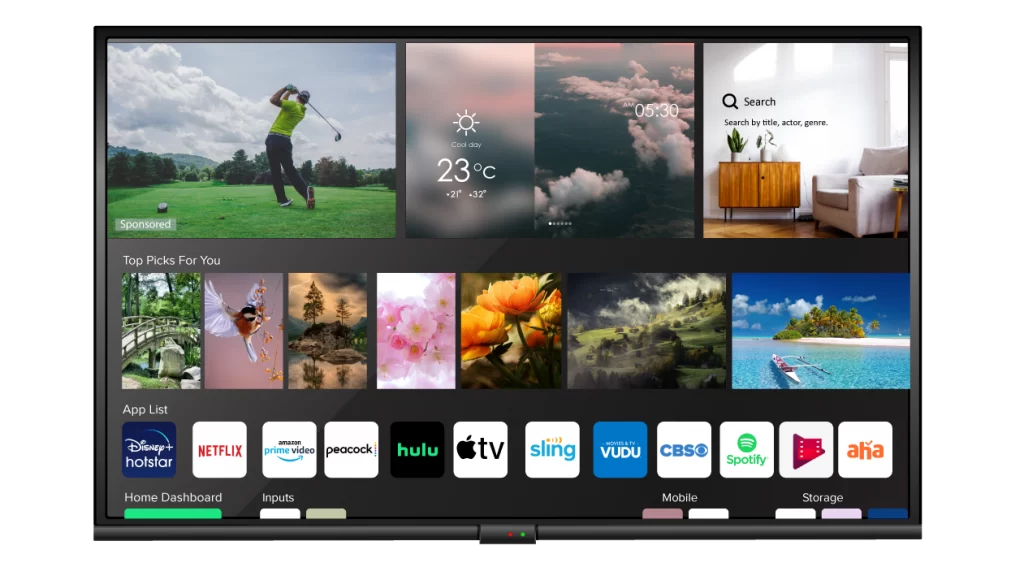
WebOS, an abbreviation for Web Operating System, stands as a Linux-based operating system exclusively owned by LG and primarily integrated into smart TVs.
This system lets users with accessibility and control, providing a sophisticated set of features and connected devices through a user-friendly Graphical User Interface (GUI).
The Evolution of WebOS
Originally introduced by Palm in 2009 as a mobile operating system, WebOS initially found its place in a number of Palm and HP smartphones.
Following its usage in smartphones, it underwent modifications at HP for integration into tablet PCs. In 2013, LG acquired WebOS from HP, leading to the latter’s decision to make WebOS open source.
WebOS in Smart TVs
Under LG’s ownership, WebOS underwent further modifications to transition into a smart TV operating system.
This evolution marked the birth of WebOS TV, a platform that serves as the powerhouse for LG Smart TVs.
With a foundation rooted in web-based technology, WebOS TV offers robust capabilities, allowing users to develop feature-rich web applications.
WebOS TV Capabilities
WebOS TV leverages a familiar technology stack, including HTML, JavaScript, and CSS.
This design choice provides developers with the flexibility to choose their preferred development approach, making it easier to create customized streaming OTT video platform.
This adaptability ensures that developers can utilize the full potential of WebOS TV for a more personalized smart TV experience.
What is Android TV?
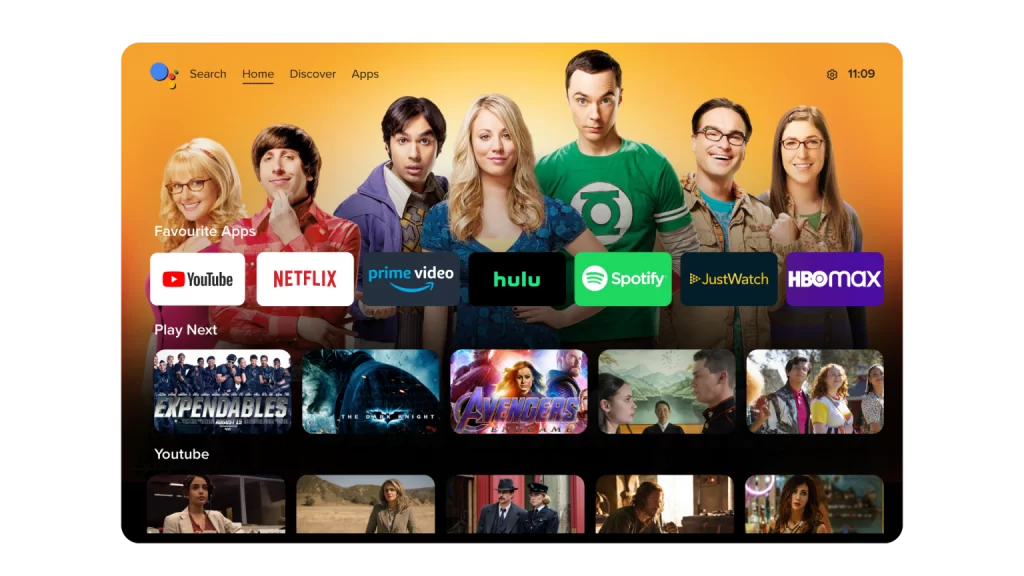
Android TV stands as a smart TV operating system rooted in the Android platform, meticulously crafted and developed by Google.
This sophisticated system finds applications across numerous devices, including digital media players, TV sets, and set-top boxes.
Google’s ingenuity in creating OTT App for Android TV is evident in its goal to enhance user experiences across various media consumption options.
Understanding Android TV’s Core Functionality
At its core, Android TV provides users with a gateway to a diverse range of applications.
With seamless integration, users can access content not only on their Android phones but also on a variety of larger screens.
This expansive approach brings an assortment of streaming apps, ranging from popular platforms like Netflix to applications for both single-player and multiplayer gaming, voice searches, and online/offline gaming experiences.
In fact, Android TV has become the go-to platform for those seeking an enriched multimedia experience on larger screens.
Android TV vs. Google TV: Dispelling Confusion
A common source of confusion lies in distinguishing between Android TV & Google TV. While both contribute to the evolving landscape of smart TV experiences, they serve different purposes.
Google TV primarily focuses on delivering content, recommendations, and related features.
In contrast, Android TV serves as the online platform through which this content is delivered. This differentiation is crucial for users navigating the diverse offerings in the smart TV ecosystem.
The Versatility of Android TV Apps
One distinctive feature of Android TV is its expansive app ecosystem. From productivity tools to entertainment applications, Android TV provides a diverse range of options.
Users can seamlessly stream both paid and free content online, transforming their smart TVs into versatile entertainment hubs.
🔰Also Read: How to Create Android TV App?🔰
WebOS Vs. Android TV
When it comes to smart TVs, the WebOS vs Android TV debate often emerges as users weigh the pros and cons of these two prominent operating systems.
Understanding the nuances and distinctive features of each becomes imperative for making an informed decision in choosing the optimal smart TV experience.
Differences Between webOS vs. Android TV
Considering smart TV operating systems, the choices between WebOS and Android TV have become central to the consumer experience.
These two platforms, each with its unique features and functionalities, cater to diverse preferences and needs.
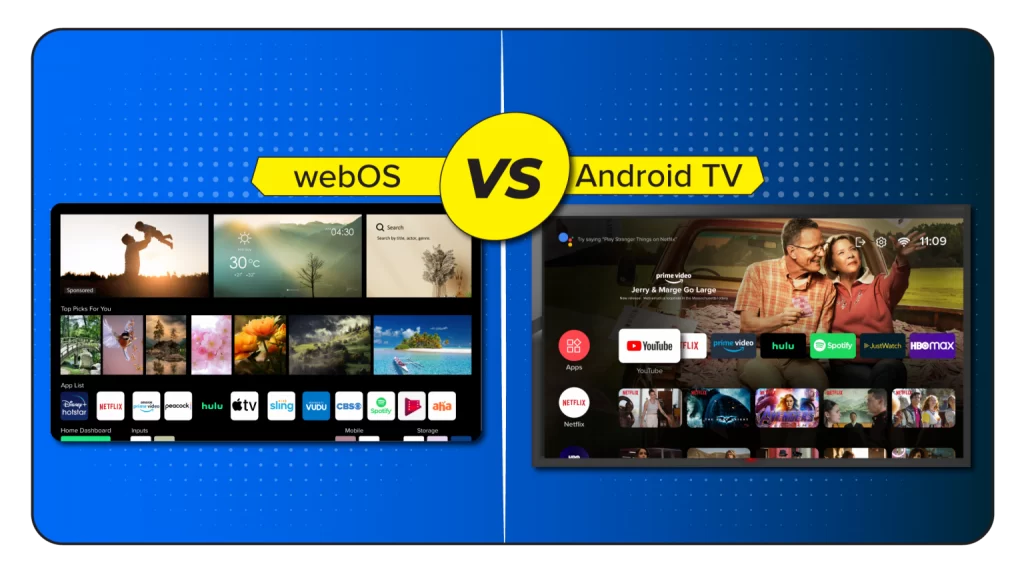
Availability Across Devices
Android TV holds a distinct advantage in terms of availability, extending its reach beyond smart TVs to include streaming sticks, set-top boxes, and a variety of other devices.
This broad compatibility has positioned Android TV as a versatile operating system suitable for different consumer preferences.
Conversely, WebOS, rooted in Linux, has traditionally been associated primarily with LG smart TVs.
However, an intriguing shift is on the horizon as LG strategically partners with other manufacturers, paving the way for the integration of WebOS into a more extensive number of OTT television models.
1. User Interface
The user interface (UI) is an important factor that profoundly influences the overall user experience on smart TVs.
Android TV and WebOS, the stalwarts in this arena, demonstrate distinctive approaches to UI design, each offering its own set of merits.
Android TV:
Android TV adopts an approach that captivates users from the moment they power up their smart TVs. The UI is anchored by a prominent content row, elegantly spanning the entire expanse of the home screen.
This design decision places a diverse content and applications front and center, creating a visually dynamic and engaging experience.
Users who appreciate a rich and interactive visual interface find Android TV’s design to be both intuitive and eye-pleasing.
WebOS:
WebOS adheres to a more minimalist philosophy, favoring simplicity and efficiency in user interaction. The UI on WebOS features a highly customizable launch bar thoughtfully positioned on the lower third of the screen.
This unobtrusive bar gracefully emerges when needed, providing users with swift access to apps, settings, and other essential features.
The minimalist design of WebOS underscores a commitment to decluttered navigation that seamlessly blends aesthetics with functionality.
2. Remote Controls
The role of remote controls in the smart TV experience cannot be overstated. Both Android TV and WebOS offer unique remote control designs, thereby enhancing the overall user interaction.
Android TV:
The remote controls designed for Android TV prioritize simplicity, offering a straightforward experience.
With a focus on ease of use, these remotes provide basic functionality that allows users to navigate through content effortlessly.
The design revolves around creating an intuitive and accessible remote, ensuring that users can control their smart TV with minimal effort.
Android TV’s emphasis on simplicity aligns with the preferences of users seeking a hassle-free and straightforward interaction.
WebOS:
LG’s innovative approach to remote control design introduces a unique point-and-click functionality, taking up the navigation experience to a new level of precision and intuitiveness.
This design choice caters to users who appreciate a more responsive control experience.
The point-and-click functionality enables precise selections and enhances the overall fluidity of navigation within the WebOS ecosystem.
LG’s commitment to providing users with a remote control that goes beyond the conventional aligns with the brand’s dedication to innovation.
3. Apps
The selection of applications forms a pivotal aspect of the smart TV user experience, and the divergence between Android TV and WebOS in this realm is noteworthy.
Looking To Build Your Own OTT Video Platform?
Start and Grow Your Video Streaming Service With 1000+ Features & 9+ Revenue Models.
Highly Customizable
Life Time Ownership
Own 100% of Your Revenue
Full-Branding Freedom
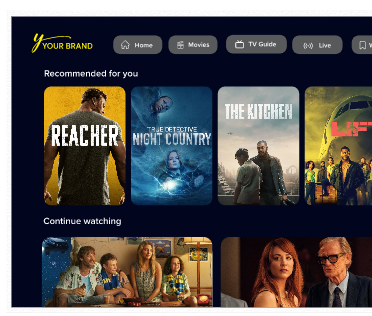
Android TV:
For Android TV users, a number of applications await within the expansive confines of the Google Play Store.
This vast library encompasses a wide array of popular content and applications, ensuring users have access to a diverse range of entertainment options.
Android TV goes beyond the conventional, providing users with the unparalleled flexibility to sideload apps that are not officially available on the Google Play Store.
This capability significantly broadens the scope of available content, allowing users to curate a more personalized and enriched viewing experience.
WebOS:
Conversely, within the WebOS ecosystem, users have access to fundamental applications that cater to essential functionalities. However, currently lacks support for sideloading applications.
This notable limitation imposes constraints on the range of applications available to end users, as their selection is predominantly confined to those offered within the ecosystem.
While WebOS ensures access to essential apps, the absence of sideloading limits the platform’s adaptability to user preferences and evolving content trends.
4. Screencasting
Screencasting, a fundamental feature allowing users to mirror content from their smart devices onto a larger screen, has become a standard and integral component of the smart TV experience.
Android TV:
Android TV takes screencasting to new heights by integrating Chromecast technology. Yes, you read right!
This innovative feature empowers end users or viewers to share all types of content effortlessly from a diverse array of supported apps.
Whether it’s streaming content from popular platforms, Android TV’s Chromecast functionality enhances the overall content-sharing experience.
The built-in Chromecast technology ensures a smooth and versatile mirroring process, allowing users to enjoy their favorite content on the expansive canvas of their smart TV.
WebOS:
WebOS, on the other hand, introduces the Smart Share feature as its screencasting solution. While not as versatile as Chromecast, Smart Share stands as a reliable method for mirroring multimedia content onto the TV screen.
Although it may not boast the extensive app compatibility found in Chromecast, WebOS ensures that the users can enjoy diverse content from their smart devices on a larger display.
In fact, Smart Share’s emphasis is on providing a dependable and user-friendly screen casting experience within the WebOS ecosystem.
Hire Dedicated Development Team to Develop Your WebOS /Android TV App
Creating a standout WebOS or Android TV app demands more than just an idea; it requires a dedicated team.
At VPlayed, we offer a unique solution to this conundrum. We lend our dedicated OTT developers to help you build, customize, deploy, and maintain your WebOS or Android TV app.
Here’s why this approach is a game-changer and how you can benefit.
- Flexible Hiring Model: Tailor your development team precisely to your project’s needs, effortlessly scaling it as required.
- Ready-to-Work Team: We have a team of 300+ dedicated OTT app developers. Our developers are experts ready to dive into your project, ensuring immediate progress.
- Add or Remove Any Features: With dedicated developers, you can adapt your app to changing user preferences by adding or removing OTT features.
- 100% On-Time Delivery: We pride ourselves on delivering projects on time, ensuring your app launches as planned.
- Intuitive UI/UX Designs: Our designs prioritize simplicity, consistency, and mobile responsiveness, ensuring a user-friendly experience. We help you create a user-friendly and visually appealing Tizen TV or/Android TV app.
- Multi-Device Support: Your app will seamlessly function on various devices and platforms, reaching a broader audience.
- Multiple Cloud Deployment: We offer deployment on renowned cloud servers like AWS, Microsoft Azure, or Google Cloud Platform. It extends your app’s reach and reliability.
So, in a nutshell, VPlayed offers you the highest cost-to-benefit ratio to build your own WebOS/Android TV app in the industry.
Conclusion:
The significance of a smart TV’s operating system cannot be overstated, as it forms the nucleus of the user experience.
Despite this pivotal role, potential buyers often base their choices on the operating system. Android TV and WebOS present distinct advantages and drawbacks, contributing to the complexity of decision-making.
WebOS stands tall for its simplicity, offering a streamlined UI and navigation experience. On the other side, Android TV boasts a number of advantages, including access to a broader range of Google Play apps, as discussed above.
However, users’ considerations extend beyond the OS to encompass design, hardware specifications, pricing, and more when selecting a smart TV.
In light of these considerations, it becomes imperative for those venturing into WebOS or Android TV app development to weigh these prime aspects carefully.
By staying attuned to user expectations and technological advancements, developers can ensure their WebOS or Android TV apps remain relevant, engaging, and well-suited to the needs of smart TV enthusiasts.
- Request Demo Book a Live, Personalized Demo
- Contact Sales Reach Out to Our OTT Experts
Frequently Asked Questions (FAQ)
1. What is LG WebOS?
LG WebOS is a Linux kernel-based multitasking operating system for smart TVs that are designed to offer control and access to more complex LG Smart TV capabilities and connected devices via a graphical user interface (GUI). In addition to that, WebOS has a more basic approach to UI, navigation, and so on.
2. What is Android TV?
An Android TV is just a television that runs the Android operating system. When compared with traditional Smart TVs, Android TV clearly outperforms them as it gives you access to the Google Play store, where you can download and update the most recent app versions. With Android TV, you can easily cast photographs, movies, music, and other content from your favorite device onto your TV.
3. What are the advantages of LG WebOS?
LG’s webOS is widely regarded as one of the best platforms as it delivers what you want, when you want it, and without fuss. Everything from news to sports to entertainment will be at your fingertips. If you have a newer version of webOS, you may enjoy features like content recommendations and the Netflix-like cards interface.
4. What are the advantages of Android TV?
With Android TV, you get a lot more functionality and a lot more stuff to view; it even allows you to download games on your TV, making it more than just a normal TV. Not only do you get Google and YouTube with Android TV, but you can also watch shows on Netflix, Amazon Prime, and any other service that you enjoy.
5. What is the difference between LG WebOs and Android TV?
Simply put, Android TV is the most widely distributed of the two operating systems. Android TV is available on devices, including streaming sticks, set-top boxes, etc. WebOS, on the other hand, is currently exclusive to only LG smart TVs. However, change is on the way as LG has begun preparing to collaborate with other manufacturers to have the OS installed on other television models as well.
6. How does LG WebOS work?
LG WebOS works in such a way that it allows you to engage with the Smart TV and allows the TV to do what you want it to. This involves using a graphical user interface to operate and access more advanced capabilities and connected devices (GUI). Other functions include browsing apps for installation, executing apps, and running the TV itself.
